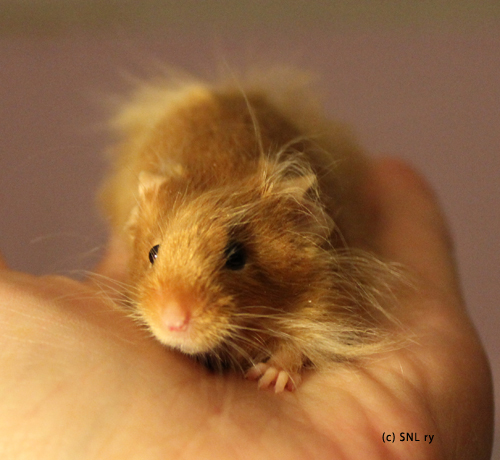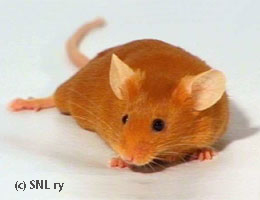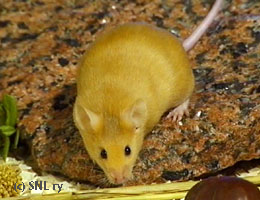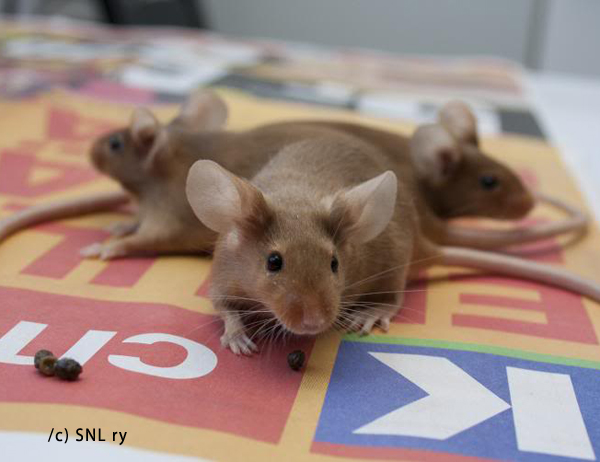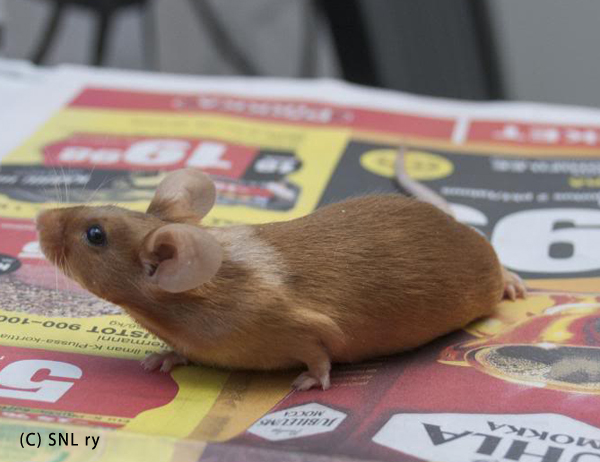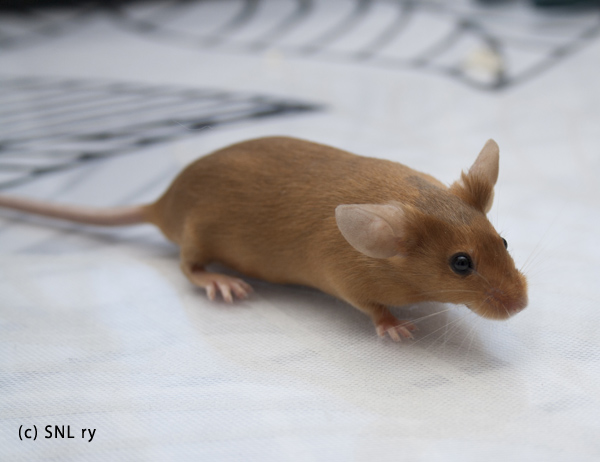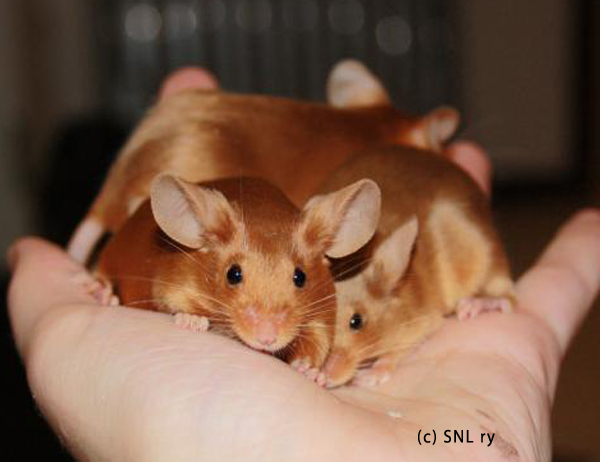Varieties
I - Self
Red (r)
Ay/* B/* C/* D/* P/*, or
Ay/* bc/* C/* D/* P/*
"The colour should be rich, deep and sparkling with no sootiness. Eye black."
Breeding information below the pictures, Ay, breeding information below the pictures, e/e
Quick Look
Red is a very old mutation. There are records of "yellow mice" in Chinese annals dating back to 80 bce. Closer to western mouse fancy and our times, one should mention that red is one of the original varieties of the British National Mouse Club at its foundation in 1895.
Red is a beautiful, but difficult variety to breed to standards. When it meets the standards, it's a stunningly beautiful colour. Even a bad red is rather charming. There's a huge variety in shades from nondescript yellow to deep, sparkling red. The shade is affected by modifiers, red pigment intensifiers and dilutions like the blue dilution d and the leaden dilution ln.
No exceptionally beautiful a mouse variety comes without problems. With red, the main problem is a genetical one. Ay, the gene that makes red, is also one of the obesity causing genes in mice. Obesity bring fertility problems to both does and bucks: Bucks may have it difficult to perform due to their excess weight, or lack the drive to stud. Does may be fully able to breed, but their obesity can hinder their fertility, or cause difficulties in giving birth.
Common faults in addition to those mentioned above include: the colour is yellow instead of read; the colour is bright orange to red instead of deep red; the mouse is sooty; light belly. Tan hairs aren't obviously a problem - they don't show.
It's also common for reds to have smaller ears, smaller size and poorer type than many other varieties.
Genetic Background
Genetically speaking, red is a mouse with Ay and no dilutes in the c, d or p-locus. The other a-locus gene and the b-locus genes aren't that relevant for a red, although a "self chocolate" background seems to work better than "self black" background. This is because the chocolate dilution lightens the possible sootiness present to a more invisible form.
The official name of the gene (in geneticist' parlance "allele") that makes a mouse red instead of agouti (wild type) is "lethal yellow" and it is a spontaneous mutation of agouti. Both fanciers and geneticists use the same symbol: Ay. The gene is the top dominant in the agouti locus and it is located in chromosome 2.
In its mode of action, Ay is similar to ae, but in the other end of the pigment variance scale: all pigment the mouse has is yellow.
The colour of the mouse is changed from wild-type banded hair colour to self red because the hair follicles of an Ay animal produces only the yellow (red) pigment, but not black. Due to the action of modifiers, in some mice this doesn't happen completely and some hairs (especially on the back and the top of the head) will have brown to black hairs. In other words: the mouse will be sooty.
The obesity problem inherent to the gene is due to fat cell hypertrophy (excessive growth). Even those Ay mice that can be kept at a normal weight, have higher total fat tissue mass than normal mice. Reds are also more prone to have tumours.
As has been noted, red is a heterozygous variety. This means that due to genetic reasons Red is always the result of two different a-locus genes. One of these genes has to be Ay, but as the lethal yellow is the top dominant of the a-locus, the other one can be any other a-locus gene there is. There are no and cannot be homozygous reds because of the gene's lethality.
The basic, unselectively bred for Ay colour varies from yellow to orange. The rich, deep red called for in the standard has to be bred for, breeding in intensifiers. Intensifiers work like umbrous determinants and other modifiers do, but they aren't linked or related to the umbrous determinants.
In More Practical Terms...
Red is one of the three heterozygous self varieties in standards (the other two being fawn and bone). As a heterozygous variety, it can never breed true. "Breeding true" is a breeders' term, meaning "breeding two of the same colour will bring you only young of that colour (given that there aren't hidden recessives in the parents)".
Even though red is a difficult variety, it is by no means one of the varieties with nigh impossible to gain standards. If you truly want to breed reds, be prepared for setting long time scale goals and housing a relatively large number of mice who are almost the perfect colour, but not quite there yet. However, once you get to your goal, it will be worth all the trouble. A beautiful red is a truly stunning mouse indeed.
Red is a colour that is easy to get on a mouse in a basic form. However, unless the red mouse in a breeding is of good quality and the mouse it has been mated with is of suitable colour and free from faults tending to ruin Red, the resulting reds won't have good colour.
It could be simply said, that red is an easy colour to ruin but hard to get (back) good.
Red to red matings produce litters 25% smaller than the average litter due to a genetic lethal factor. Red to red mating would still be the best for the colour, but after continuous matings these will produce fat mice with a poor type: small ears and short thin tails. Good outcrosses are therefore needed.
All prospective outcrosses for a red should be free from faults or qualities disastrous for the red. One should always be on guard against letting umbrous (U/*) in the stock!
A breeder setting out to produce the best possible red should be on a look-out for as uniformly coloured and deep red Reds as possible, with as little sootiness as possible. Reds require co-bred varieties and for these, the serious breeder searches excellent agouti or cinnamon mice (there must be no umbrous in these mice!) or good quality chocolates or chocolate tans. Both chocolate and chocolate tan can bring in umbrous (U), causing "chocolate sables" to pop in the lines. Black and black tan can be rather problematic co-bred varieties, as the best specimens of these two varieties more often than not have U/*.
Blue, lilac, the red-eyed varieties, chinchillated ticked varieties, all of the silver-ticked varieties and all shaded and pointed varieties are all definitely unsuitable for outcross.
Blue and lilac will bring in blue (or at least leaden) dilution, which cuts the density of red pigment. The pink eyed dilutions turn the colour lighter (due to the modifiers being selectively bred towards lighter colours on pink eyed varieties) and bring in the pink eye dilution p, causing the line to throw fawns.
Basically, all c-locus recessive varieties are ruinous to the colour of red. The chinchilla dilution turns red to cream, other c-locus recessives turn the red pigment into white.
Starting From Scratch?
In order to have reds, one needs to have the Ay gene. If there are no reds available, the gene can be obtained from fawn. Mate the fawn with a good cinnamon or chocolate.
The needed Ay can be found also in all sable varieties (including the martens), but using these can be very problematic, as all of them have U/* and other shading darkening genes. You can find the lethal yellow on a cream, but while it is possible to get some kind of Red from a basic cream x cinnamon cross, the cch of the cream can cause problems later on.
Poor Red or Poor Sable?
It can be difficult to tell a sooty red apart from a too lightly shaded Sable. Whether one calls these mice "red ut" or "sable ut" is most often a question of personal preference. However, I have noticed differences in mice of the red - poor red - poor sable - sable scale:
- Red: hair red all its lenght,
- sooty red: the tip of the hair is darker, ranging from brown to black (or sometimes having a darker band mid-hair),
- sable: on the back the hairs are all dark, on the belly they are all red, on the shadings the proportions of dark and red pigments gradually change from hairs tipped with dark pigment through hairs banded with dark and hairs with dark roots to all red hairs.
Recessive Red?
Another gene to cause red colour in mice is called recessive (or viable) yellow, e. Recessive red doesn't have the genetic tendency for obesity the dominant yellow has (though some e/e reds do get fat). This doesn't make the variety without it's own difficulties: it is harder to get truly red and the colour takes time to develop. Often you will get rather odd-looking youngsters, who look like quite other varieties (say, cinnamon). However, you can tell e/e youngsters apart by looking at their undercolour: e/e babies have orange to red undercolour. With successive molts, the coat turns redder. In the early stages of the colour development, you seem to be able to tell rather easily, what variety the mouse would be if it didn't have e/e.
You can influence the amount of sootyness (and thus the amount of wrong-coloured hair tips) by selective breeding. This influence can go both ways: decreasing and increasing it.
One of the interesting oddities with e/e is that when the gene is combined with leaden (e/e ln/ln), you won't get a red mouse. Instead, you'll get a blue one. Leaden "turns recessive red off".


